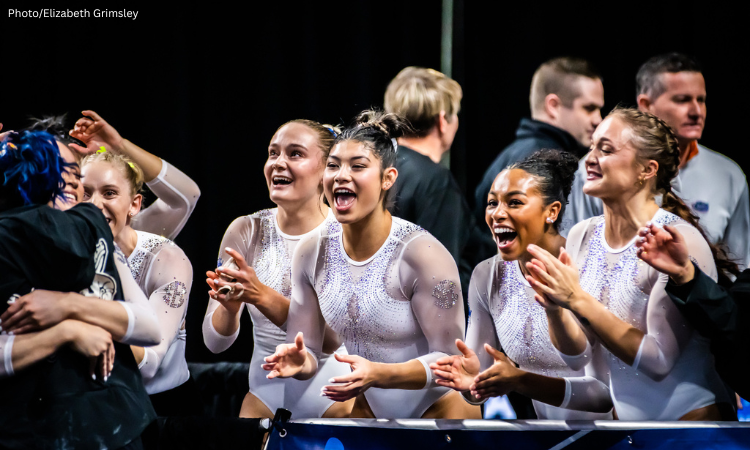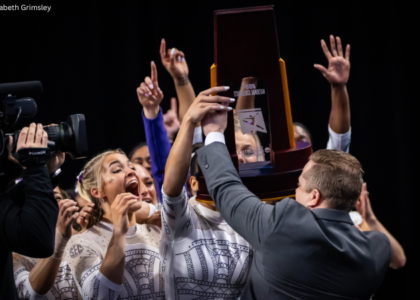Week nine brought one of the busiest gymnastics weekends of the year, with 17 teams competing more than once. Rest time can be crucial for a gymnast, but so is preparing for the postseason where a team must compete twice in a weekend to advance. How do teams perform with minimal rest time? Do we see lower scores with less rest? Do we see more gymnasts being rested when a double is on the schedule? We dove into the data to find out.
Score Differences
For this analysis, we looked at all regular-season meets going back 10 years. We excluded postseason meets because, on average, they occur closer together and team strategy may be different at that point in the season.
First, we calculated how many days there are between meets and found that it’s most common for there to be exactly seven days between meets, though they do often fall six or eight days apart, for example, if a meet is on a Friday one week but Saturday the next, or vice versa. According to our data, we found that having two days between meets is the most common spacing for a double-meet weekend. However, we are considering one to three days between meets as qualifying as a double for this analysis. Teams occasionally have more than 14 days between meets. For our purposes we’re grouping all of those meets into the “14+” category.
How often teams schedule doubles varies quite a bit across schools. Since Alaska is so far away from other schools, it competes the majority of its meets as doubles, with over three-quarters of its meets being doubles. On the other end of the spectrum, Florida hasn’t had a regular-season double in the past 10 years, showing that teams don’t need to schedule doubles in the regular season to have post-season success.
Next, we calculated the team score difference in a given meet versus the previous meet. Scores tend to build throughout the season, so we expect this number to be positive on average. Across the entire dataset, we see that scores increase on average 0.175 points in each meet. We then calculated the average score difference by the number of days since the last meet. Interestingly, it is not the shortest rest times with worse performance, but what we classify as the more unusual rest times, in this case four to five days and 11 to 12 days. Meets with only four or five days of rest typically occur when a team competes once on Sunday or Monday followed by a Friday meet the subsequent weekend. The same is true of 11 to 12 day rest periods, with an extra week of rest in between. These meets are considered separate weeks from a scheduling perspective but have less rest time compared to normal weeks and as a result see lower performance.
Another interesting finding is that doubles, which we’ve defined as one to three days between meets, do not have lower scores on average. In fact, we typically see scores increase by over 0.300 when teams have only one or two days of rest.
To explore this further, we classified all meets as either the first meet of a double, the second meet of a double, or a single meet, and looked at the average score increase from the meet preceding it. What we found is that teams typically have a much smaller score increase (only 0.05 points) in the first meet of a double-meet weekend, possibly because they are conserving energy for the next meet. In the second meet of the weekend, we see a much larger increase in scores (0.325 points).
Lineup Consistency
In addition to exploring score differences, we were curious to see how lineups differ when teams have limited rest. We hypothesized that we’d see more lineup changes when rest time is limited to avoid overworking a gymnast. To explore this, we brought back the Lineup Consistency Score (LCS) explored previously. In that analysis, we found that the average LCS was 90.5%, meaning only about 10% of a team’s lineup changes on average. To explore the variation in LCS across the number of days between meets, we flipped LCS on its head and studied the Lineup Inconsistency Score (LIS), which is defined as 100-LCS, or the percent of the team’s lineup that changes on average. An LIS of 0 means the lineup was identical to the previous meet.
Our hypothesis was correct when it came to meets on back-to-back days. With only one day since the previous meet, we see on average 12% of lineups changing, 2% higher than the average across the season. However, in a double-meet weekend with two to three days in between meets, we see the opposite effect with only 6 to 7% of lineup spots changing on average. Teams may do this to better prepare for the postseason where they’d expect their top gymnasts to go up in both meets. We also see a larger LIS when there are 10+ days between meets, so expect lineups to shake up a little more on average when teams have a bye week.
Overall, we see that rest time does impact both scores and lineup consistency, but not necessarily in the ways we expected. Teams with atypical rest times, such as four to five days, see a decrease in scores on average, while we see larger increases in scores on the second meet of a double-meet weekend. We also see more consistent lineups on double-meet weekends as long as the meets are not on back-to-back days. With eight more doubles on the schedule this weekend, keep an eye out for these trends to continue.
READ THIS NEXT: Data Deep Dive: Which Event Is Most Important to a Team’s Success?
Article by Claire Harmon





3 comments